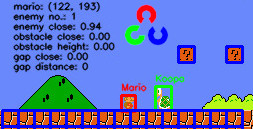Using Q-learning to play Super Mario Bros for the Nes.
Both neural networks and replay buffers are based on tutorials from Adventures in Machine Learning
Requirements
gym: pip install gym
nes-py: pip install nes-py
Super Mario:pip install gym-super-mario-bros
numpy: pip install numpy
tensorflow: pip install tensorflow
visual studio: For windows install the “Desktop development with C++” workload
Training the Agent
python main.py
| Arg | Default | Description |
|---|---|---|
--env |
SuperMarioBros-1-1-v0 | Gym environment and level |
--dueling |
Change from DDQN to Dueling DQN | |
--per |
Change from stander replay buffer to Performance Experience Replay | |
--frame_size |
(84, 84) | Change the Resolution to decrease computational load |
--max_timesteps |
5e5 | Total timesteps the environment will play |
--delay_timesteps |
1e4 | Initial timesteps to fill the replay buffer |
--min_epsilon |
0.01 | The lowest value for epsilon |
--epsilon_decay |
45e4 | Timesteps required to reach the minimum epsilon |
--beta_decay |
45e4 | Timesteps required to reach the maximum beta |
--learning_rate |
1e-3 | Learning rate for the optimizer |
--gamma |
0.99 | The discount factor for Q(s’,a’) |
--tau |
0.05 | The rate for updating the target network |
--memory_size |
131072 | The size of the memory buffer. PER requires 2^x’) |
--batch_size |
64 | The size of the mini-batches for Q learning |
--debug_summary |
Save tensorboard summaries of training | |
--save_model |
Store the models at set intervals | |
--save_freq |
5e4 | The intervals when the models’ weights are saved |
For Example, if you wanted to train a DDQN Model with a PER memory buffer using mini-batches of 32 samples:
python main.py --per --batch_size 32

